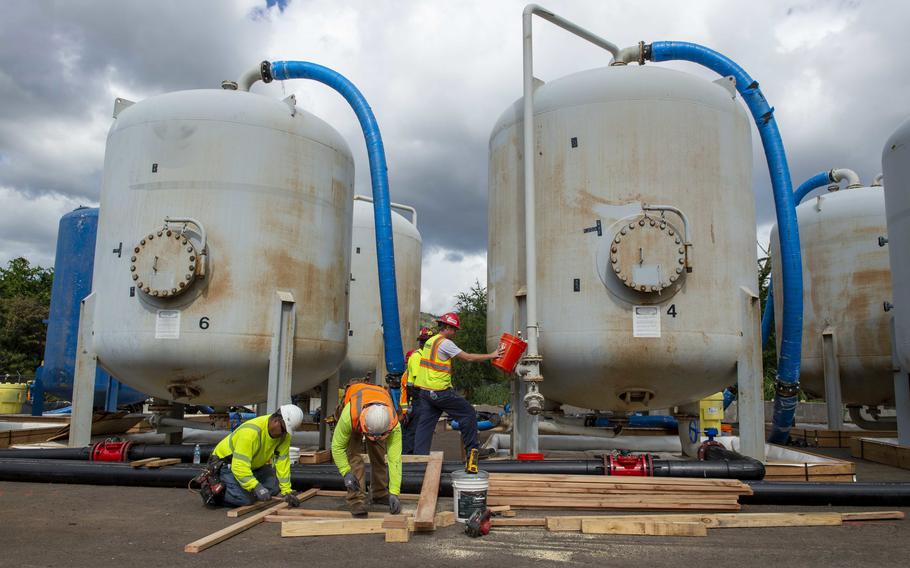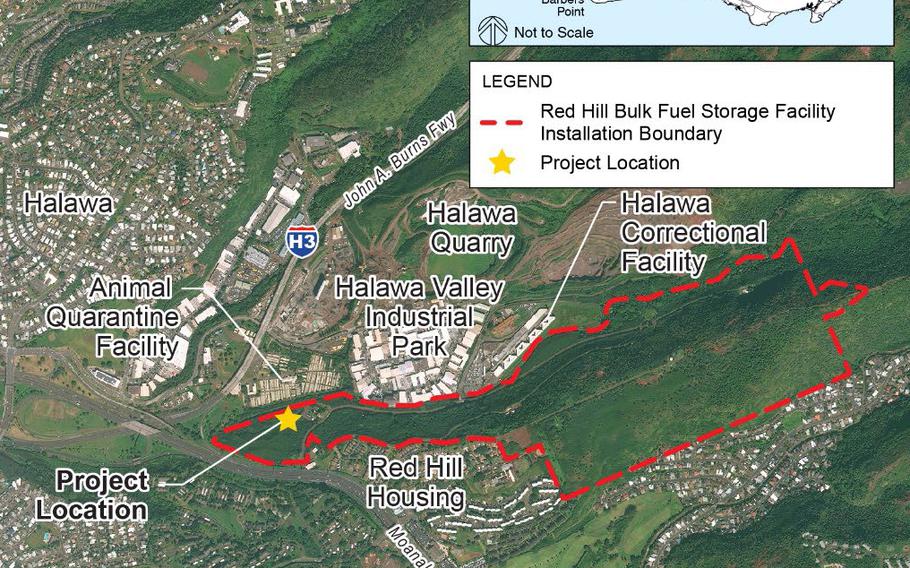
Navy contractors prepare granular activated carbon filter systems to filter out petroleum contamination in the Red Hill shaft in Aiea, Hawaii, in January 2022. (Luke McCall/U.S. Navy)
FORT SHAFTER, Hawaii — The Navy plans to build treatment plants near Joint Base Pearl Harbor-Hickam that would purify the fuel-contaminated water in the Red Hill water shaft for use in its drinking water system.
The service is seeking public comment through April 20 on a draft environmental assessment outlining plans to construct interim and permanent treatment facilities on the grounds of the Red Hill Bulk Fuel Storage Facility.
The World War II-era facility is in the process of permanent shutdown after a 2021 leak contaminated the aquifer.
The interim treatment facility, which would filter the water using granular activated carbon, is already under construction and expected to be completed in 2026, the assessment states.
No timeline was given for the subsequent completion of a permanent water treatment plant.
Water from both treatment facilities would meet drinking water standards set by the U.S. Environmental Protection Agency and the Hawaii Department of Health, the assessment states.

A Navy map shows the location for planned water treatment facilities within the boundaries of the Red Hill Bulk Fuel Storage Facility near Joint Base Pearl Harbor-Hickam, Oahu, Hawaii. (U.S. Navy)
A jet fuel leak in November 2021 contaminated the Red Hill water shaft, one of three sources the Navy used in a distribution system serving more than 90,000 people in military housing communities on and near the joint base.
Many residents complained of ill health after consuming and bathing in the water. Thousands were relocated to area hotels for months as the Navy flushed and cleaned the system.
The Red Hill shaft, which extends horizontally through the aquifer, was isolated from the Navy’s water system in the wake of the contamination.
The Navy stopped pumping its Aiea-Halawa shaft in early December 2021 after traces of petroleum contamination were detected in it, leaving the Navy’s water system solely dependent on the Waiawa shaft.
In January 2022, the Navy installed a series of massive carbon filters at the Red Hill shaft site. Each day, millions of gallons of tainted water are pumped up, filtered and released into the nearby Halawa Stream.
The continuous pumping is intended to prevent petroleum contamination in the well from migrating elsewhere.
The planned interim treatment facility would replace the existing emergency filtering system, the assessment states. The interim plant would initially continue to pump treated water into the Halawa Stream.
It would later be connected to the Navy’s drinking water system following completion of the environmental assessment process and approval by the Hawaii Department of Health, the assessment states.
In an email Tuesday, Wayne Tanaka, chapter director of the Sierra Club of Hawaii, said he would welcome ending the waste of draining millions of gallons of water daily into the stream.
But he said he was concerned that the draft assessment did not address the need to test soil in the construction area for the presence of toxic chemicals known as PFAS.
In addition, the treatment facilities “must also not be used to excuse the Navy from its responsibility to remediate the environment itself — especially with up to 2 million gallons of fuel and other toxic chemicals that may have been released over our island’s primary drinking water aquifer throughout the last 80 years,” he said.
The Hawaii Department of Health in February gave the Navy conditional approval to begin using water from the Aiea-Halawa shaft, provided the water would be filtered using a granular activated carbon system, among other requirements.
Some members of the Red Hill Community Representation Initiative have questioned the “safety and transparency” of the decision to restart use of that shaft.
The group consists of 10 members from the Hawaiian community who work directly with the Navy, Defense Logistics Agency and EPA on matters related to the defunct Red Hill facility, including its defueling, permanent closure and drinking water safety.
“This community has already suffered enough,” Healani Sonoda-Pale, a member of the CRI, said in a March 26 news release.
“We will not stand by while the Navy quietly turns the tap back on without full transparency and accountability,” she said.
The draft environmental assessment for the Red Hill shaft treatment plants can be viewed at https://pacific.navfac.navy.mil/About-Us/National-Environmental-Policy-Act-NEPA-Information/.
Written comments can be mailed to the attention of Red Hill Water Treatment Facility, EA Project Manager, Naval Facilities Engineering Systems Command Hawaii/EV21, Building 55, 400 Marshall Road, Joint Base Pearl Harbor-Hickam, HI 96860-3139, or emailed to RedHillEA@hhf.com.
Comments must be received or postmarked by April 20.